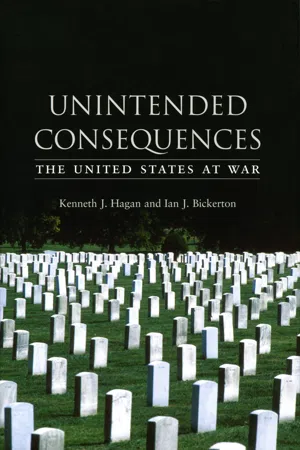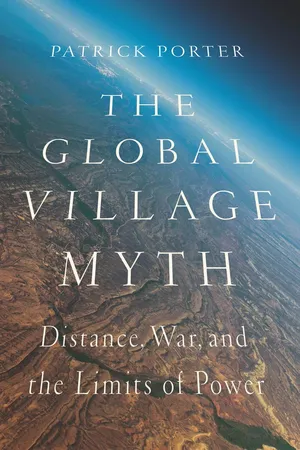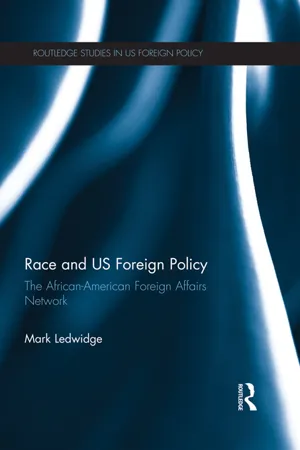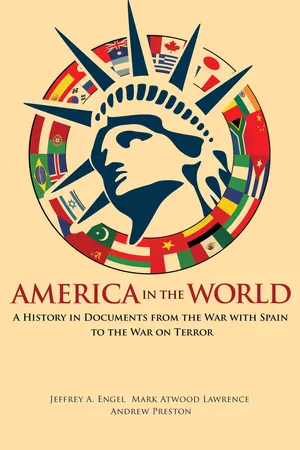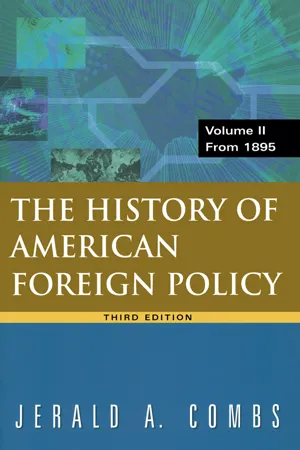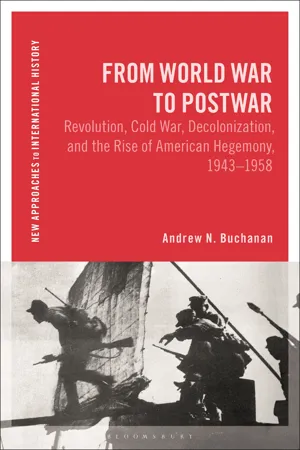History
America enters WWII
America entered World War II after the Japanese attack on Pearl Harbor on December 7, 1941. This event prompted the United States to declare war on Japan the following day. Subsequently, Germany declared war on the United States, leading to America's full involvement in the global conflict.
Written by Perlego with AI-assistance
Related key terms
1 of 5
8 Key excerpts on "America enters WWII"
- eBook - ePub
Unintended Consequences
The United States at War
- Kenneth J. Hagan, Ian J. Bickerton(Authors)
- 2007(Publication Date)
- Reaktion Books(Publisher)
SEVENTHE UNITED STATES INWORLD WAR II , 1941–45
The world is heading toward a secret armament race of a ratherdesperate character.Henry L. Stimson to Harry S. Truman, 11 September 19451World War II was the most cataclysmic war in human history. This war unleashed darker passions, killed more people, and utilized more powerful and deadly weapons than any war in human experience. It was a war almost beyond comprehension in its totality, brutality, scale and scope. It was a war that defined peoples, nations and the twentieth century. In many ways, the sheer scale of the war has discouraged, if not prevented, a detached assessment of its meaning and consequences.If the United States held true to the idealism, utopianism and universal values espoused by Woodrow Wilson only two decades earlier, then World War II was a war that should have engaged the United States from its outbreak in Europe in 1939. If the realpolitik articulated by other American leaders had any lasting substance or significance beyond empty political rhetoric and hypocrisy, then the United States should have entered it without hesitation. If Americans believed in the efficacy of war – and they surely did – then their failure to act quickly and decisively at the onset of the European war contributed greatly to the magnitude of the war’s unintended consequences.Instead, the United States initially stayed aloof from the conflict engulfing the world, declaring itself neutral until attacked by Japan in December 1941. Or it appeared to stay aloof. In reality, President Franklin Delano Roosevelt involved the United States surreptitiously by assisting Great Britain in the European theatre. In the Far East he embargoed oil shipments to Japan, a policy he knew or believed would provoke Japan into an attack on American interests in the Pacific, necessitating an American armed response. In so doing, Roosevelt was following the example of President Wilson during World War I - eBook - PDF
- Jane Kamensky, Carol Sheriff, David W. Blight, Howard Chudacoff(Authors)
- 2018(Publication Date)
- Cengage Learning EMEA(Publisher)
At war’s end, although many Americans grieved for loved ones lost in battle and worried about the stability of the emerging post- war order, the United States had unprecedented power and unmatched prosperity among the world’s nations. ■ What factors brought the United States into the war? ■ What military, diplomatic, and social factors influenced decisions about how to fight the Second World War? ■ How did World War II transform the United States? 23-1 America’s Entry into the Conflict ▶ ▶ How did Franklin D. Roosevelt draw the United States closer to war? ▶ ▶ How did American attitudes about involvement in the war evolve after 1939? ▶ ▶ What was the nature of the relationship between Japan and the United States prior to the bombing of Pearl Harbor? Winston Churchill British wartime prime minister; close friend of FDR and staunch ally of the United States; served 1940–1945 and 1951–1955. Copyright 2019 Cengage Learning. All Rights Reserved. May not be copied, scanned, or duplicated, in whole or in part. Due to electronic rights, some third party content may be suppressed from the eBook and/or eChapter(s). Editorial review has deemed that any suppressed content does not materially affect the overall learning experience. Cengage Learning reserves the right to remove additional content at any time if subsequent rights restrictions require it. CHAPTER 23 The Second World War at Home and Abroad | 1939–1945 668 (air force) launched massive bombing raids against Great Britain in preparation for a full-scale invasion. Alarmed by the swift defeat of one European nation after another, Americans increasingly questioned isolationist principles. Some liberals left the isolationist fold; it became more and more the province of conservatives. Emotions ran high. Roosevelt called the isolationists “ostriches” and charged that some were pro-Nazi subversives. More significantly, the president worked to prevent the fall of Britain. - eBook - ePub
The Global Village Myth
Distance, War, and the Limits of Power
- Patrick Porter(Author)
- 2015(Publication Date)
- Georgetown University Press(Publisher)
To understand globalism’s ascent, it can be plotted around three crucial dates: December 7, 1941, June 25, 1950, and September 11, 2001. On each date, enemies inflicted a surprise attack on American interests, whether the Pacific Fleet anchored in Pearl Harbor, the thirty-eighth parallel line dividing South and North Korea, and, on 9/11, cities on home soil. In the wake of these shocks, Washington strategically reassessed its position, declared a world struggle, and went to war. These conflicts were not equal in terms of scale or type. But each was an occasion where the United States widened its strategic horizons and rededicated itself to a global project.1941: Pearl Harbor and the Global Embrace
Imperial Japan’s surprise strike on Pearl Harbor on December 7, 1941 (“12/7”), persuaded Americans that old geographic barriers were obsolete and that a new era of vulnerability had arrived. Americans concluded that new weapons, communication, and transport technologies had eclipsed distance. President Franklin Roosevelt invoked globalism to justify America’s war against the Axis. Pearl Harbor showed that “we cannot measure our safety in terms of miles on a map any more.”24 New long-range capabilities, from naval aviation to air power, combined with predatory ideologies such as fascism and the overthrow of the European balance of power meant that American security could no longer be based on continental or hemispheric insulation. For the majority, the assault by a transoceanic predator demonstrated “that the rise of hostile states anywhere in the world could endanger our security.”25 A dominant Nazi Germany and Imperial Japan, it was feared, could threaten the homeland with encirclement, economic suffocation, or invasion. Great Britain played its part in feeding American fears, as British intelligence forged documents about Nazi plans for political subversion and the creation of satellite states in the Americas.26 The fear of fifth columnists at home and the sighting of Japanese submarines off the west coast quickened the sense of enemies closing in.World War II gave rise to the era of national security. This was an idea that would be institutionalized within American government and popularized in wider society. National security supplanted the more limited concept of “defense.” Military “Rainbow” plans of the interwar period had little overall policy direction from the White House or the State Department, were separate and secretive from other branches of government, and the armed services had to guess the contours of national policy.27 The disorder of the 1930s planted the seeds of an intellectual rediscovery of strategy as an intellectual discipline, and new weapons of greater range and lethality stoked fears in defense debate.28 Edward Mead Earle at the Institute for Advanced Study at Princeton, along with Arnold Wolfers and Nicholas Spykman at Yale, led the academic embrace of the concept. But only after the United States formally entered the war did national security become an organizing principle for a new, complex bureaucracy. This would culminate in the formation of the Unified Command Plan of 1946 that placed large parts of the globe under geographically based military commands, and the National Security Act of 1947, establishing the National Security Council and the Central Intelligence Agency.29 Once continental and hemispheric, America’s conception of its outer defenses became extraregional.30 “Security” now went beyond the material and territorial. “National security” as a term altered its etymology and associations, pointing to “the shrinkage of space and time.”31 - eBook - ePub
Race and US Foreign Policy
The African-American Foreign Affairs Network
- Mark Ledwidge(Author)
- 2012(Publication Date)
- Routledge(Publisher)
25 followed by US sanctions, ultimately led to US intervention in the war.The Position of African-AmericansThe IEW stimulated African-Americans’ wider appreciation, interest and recognition of foreign affairs,26 which placed them at the cutting edge of a grass-roots foreign affairs community, which led to some African-Americans’ military involvement in the Spanish civil war, where they fought against fascism. Evidently African-Americans’ interest in foreign affairs encompassed more than one foreign affairs issue. African-Americans’ desire to fight on behalf of Ethiopia and the anti-fascist forces in Spain27 indicates that (some) African-Americans embraced the concept of interventionism, which only received mainstream support after Japan’s bombing of Pearl Harbour. Clearly, AAFAN and African-Americans in general recognised the danger that Italian fascism posed to world peace, in terms of the dangerous precedent set by Italy, that military action in order to facilitate a state’s expansionist goals was permissible, while America and Europe chose to ignore Italy’s actions. Padmore highlighted British hypocrisy by stating ‘is it strange that [the British prime minister] Mr. Chamberlain denounces the wrongdoings of Hitler but remains silent about Mussolini’s brute force, bad faith, injustice and oppression’ towards Abyssinians and Albanians.28 The precedent set by both Mussolini’s aggression and America’s and Europe’s failure to respond collectively and decisively (perhaps) fuelled German expansionism, which ultimately caused the war in Europe, while European nations (and to a lesser degree America) could tolerate Japanese aggression against China, and Italy’s invasion of Ethiopia; they evidently felt that the sovereignty of European nations was worth fighting for. While African-American activities during the IEW favoured interventionism, their initial response to WWII reflected the complexity of their domestic context29 - eBook - ePub
America in the World
A History in Documents from the War with Spain to the War on Terror
- Jeffrey A. Engel, Mark Atwood Lawrence, Andrew Preston(Authors)
- 2014(Publication Date)
- Princeton University Press(Publisher)
6 World War II Before 1941 ended, Germany controlled Europe, having done in weeks what a previous generation of German militarists had failed to accomplish in years: the conquest of rival France and the near capture of Moscow. Among the continent’s great powers, only Great Britain remained beyond Adolf Hitler’s control. Conflict raged in Asia too. Japanese forces had invaded China in 1937. Weak international reaction effectively killed off the dwindling influence of the League of Nations and opened the door to further Japanese aggression. As the global situation grew darker, American policy makers faced monumental questions of war and peace: how to keep out of war; then how to win the war; and finally how to ensure war would not erupt yet again. President Franklin D. Roosevelt strongly believed it was only a matter of time before America entered the conflict, though, as noted in chapter 5, he never seriously feared a direct German (or later Japanese) invasion of the United States. What truly frightened Roosevelt, more than the specter of bombing or direct enemy invasion, was what a full Axis victory in Europe and Asia might mean for American society. To survive in such a world, Roosevelt reasoned, the United States would require authoritarian rule of its own sufficient to create a garrison state capable of withstanding further Axis incursions. To remain free, in other words, would require sacrificing the very way of life Americans valued most. He sided with Britain and its allies not only out of sympathy for their cause but also out of a genuine fear for what their defeat might mean for the United States - eBook - ePub
- Jerald A Combs(Author)
- 2017(Publication Date)
- Routledge(Publisher)
Perhaps the best evidence against a Roosevelt conspiracy is that it made no political or strategic sense. If Roosevelt had wanted to galvanize American opinion to fight the Axis, he did not have to sacrifice the fleet; a Japanese attack on an empty harbor would have sufficed. No one knew at the time that the battleships and cruisers lost at Pearl Harbor would prove obsolete and that the carriers would be decisive in the naval war to come. Besides, Roosevelt did not want war in the Pacific; he wanted to fight the far greater threat of Hitler in Europe. There was no guarantee that Pearl Harbor would bring America into the European conflict. It might even have diverted American public attention to the Pacific and made a declaration of war against Germany all the more difficult. Fortunately for Roosevelt, he did not have to request war against Germany as well as Japan. Hitler cheered Pearl Harbor and declared war on the United States. He had avoided provoking conflict while Roosevelt extended aid to Britain, but evidently he had concluded that war was inevitable. Roosevelt had waited until Japan forced his hand, but now Americans were united in their commitment to World War II.Controversial Issues
America’s entry into World War II caused far less historical controversy than its entry into World War I. World War I revisionists Charles A. Beard, Charles Tansill, and Harry Elmer Barnes survived to write parallel denunciations of World War II, but historians dismissed them far more quickly than they had the earlier ones. (These World War I and World War II revisionists are to be distinguished from the more modern revisionists who have been writing since the advent of the Cold War.) Beard, Tansill, Barnes, and their revisionist compatriots denied that either Germany or Japan had posed a serious threat to American interests or security. They admitted that Hitler was a dangerous neurotic, but his major goal had been the destruction of the Soviet Union. If Roosevelt had stood aside, Hitler and Stalin would have demolished each other. If, in the process, Germany and Japan had destroyed the British Empire as well, that was no concern of the United States. - eBook - PDF
America in the World
A History in Documents since 1898, Revised and Updated
- Jeffrey A. Engel, Mark Atwood Lawrence, Andrew Preston, Jeffrey A. Engel, Mark Atwood Lawrence, Andrew Preston, Mark Lawrence, Jeffrey A. Engel, Andrew Preston(Authors)
- 2023(Publication Date)
- Princeton University Press(Publisher)
6 World War II Before 1941 ended, Germany controlled Europe, having done in weeks what a pre- vious generation of German militarists had failed to accomplish in years: the conquest of rival France and the near capture of Moscow. Among the continent’s great powers, only Great Britain remained beyond Adolf Hitler’s control. Conflict raged in Asia too. Japanese forces had invaded China in 1937. Weak international reaction efectively killed of the dwindling influence of the League of Nations and opened the door to further Japanese aggression. As the global situation grew darker, American policy makers faced monumental questions of war and peace: how to keep out of war; then how to win the war; and finally how to ensure war would not erupt yet again. President Franklin D. Roosevelt strongly believed it was only a matter of time before America entered the conflict, though, as noted in chapter 5, he never seri- ously feared a direct German (or later Japanese) invasion of the United States. What truly frightened Roosevelt, more than the specter of bombing or direct enemy invasion, was what a full Axis victory in Europe and Asia might mean for American society. To survive in such a world, Roosevelt reasoned, the United States would require authoritarian rule of its own sufficient to create a garrison state capable of withstanding further Axis incursions. To remain free, in other words, would require sacrificing the very way of life Americans valued most. He sided with Britain and its allies not only out of sympathy for their cause but also out of a genuine fear for what their defeat might mean for the United States. Sim- ilar fears of totalitarian rule abroad diminishing American freedoms at home would in time drive early Cold War policy makers, many trained under Roose- velt’s tutelage. - eBook - ePub
From World War to Postwar
Revolution, Cold War, Decolonization, and the Rise of American Hegemony, 1943-1958
- Andrew N. Buchanan(Author)
- 2023(Publication Date)
- Bloomsbury Academic(Publisher)
Meanwhile, encouraged by officials who produced handy pocket-sized guidebooks, many soldiers spent time sightseeing, layering the hierarchical assumptions of the tourist gaze onto the explicit power relations embedded in military occupation. Much of this, along with information about art shows, opera performances and movie screenings, the location of officers’ clubs and facilities for enlisted men, and details of local religious services, was printed in the army newspaper Stars and Stripes, local editions of which—in yet another show of abundance—were published in every major theater of operations. The United States and the World War For much of the long world war that began with Japan’s invasion of Manchuria in 1931, the United States was not a combatant, and by the time Tokyo’s attack on Pearl Harbor brought it into the war in December 1941 several key military turning points had already passed. By 1940, a volatile coalition of Chiang Kai-shek’s governing Guomindang (Nationalist Party) and Mao Zedong’s Communist Party had fought the Japanese invasion of China to a halt, leaving Tokyo in control of many of the major cities but with only a marginal grip on the countryside. Meanwhile, American aid and a worldwide imperial mobilization enabled Britain to fight on after the fall of France in June 1940 and to block Italian expansionism in Egypt and the Horn of Africa. After the German invasion of the Soviet Union in June 1941, the Red Army bore the brunt of the land combat against Germany for the remainder of the war, fighting first for survival and then, with increasing mastery of mobile warfare, for victory. Axis assaults on China and the Soviet Union were thus blunted before the large-scale military engagement of the United States. Moreover, the savagery of the fighting, the genocidal violence that accompanied it, and the waves famine and disease that it generated, ensured that these Eurasian bloodlands were the site of the bulk of the war’s death and destruction
Index pages curate the most relevant extracts from our library of academic textbooks. They’ve been created using an in-house natural language model (NLM), each adding context and meaning to key research topics.
